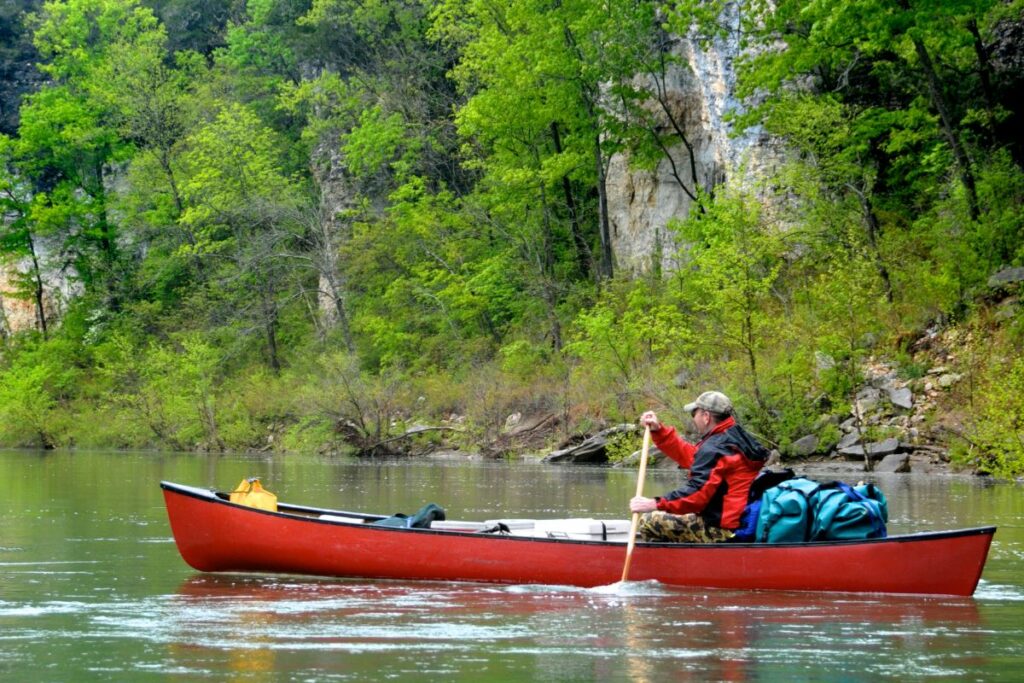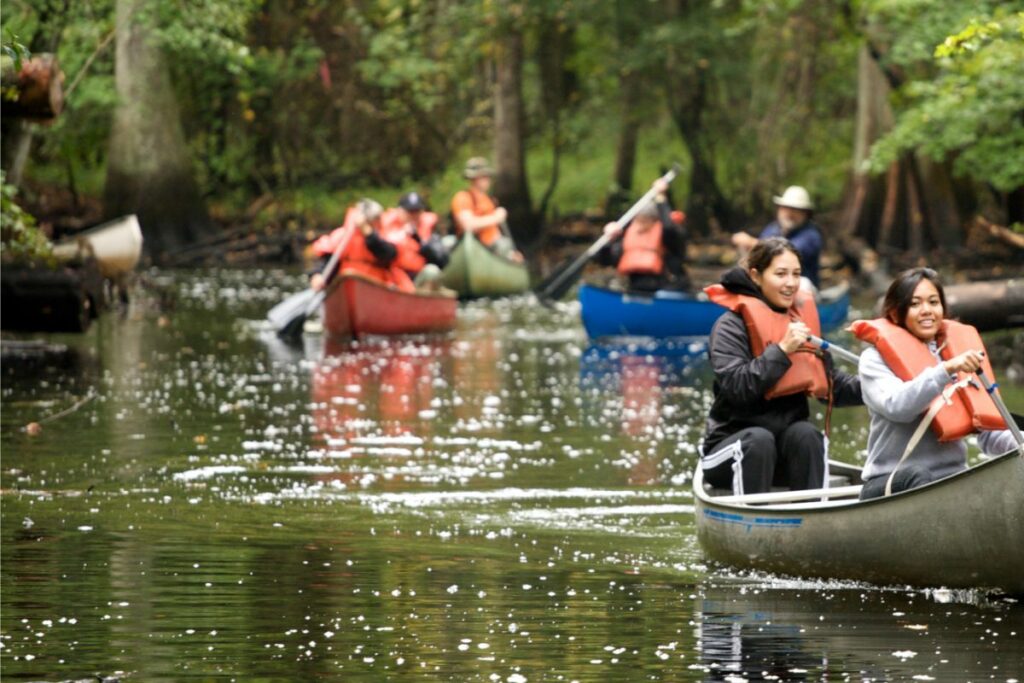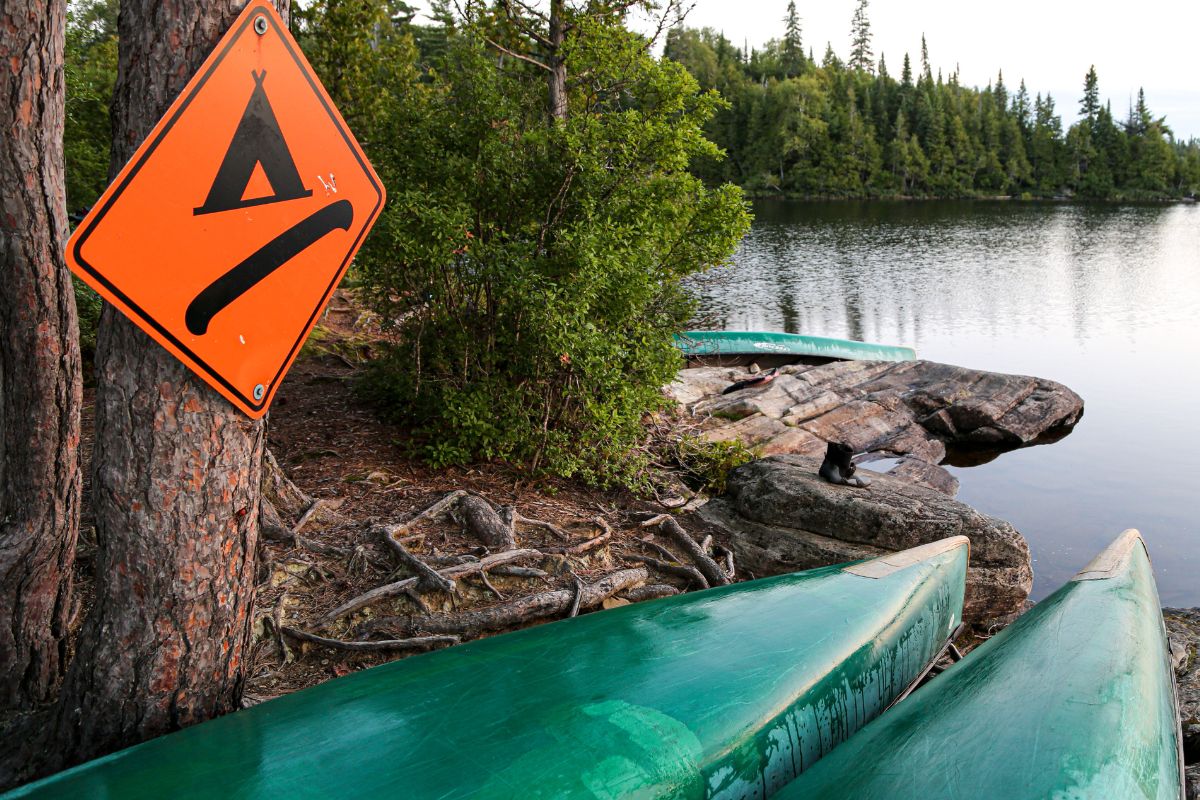Growing up in Central Florida, my buddies and I would spend entire days of our summer vacation canoeing up and down the spring-fed river that bordered our neighborhood. We knew every inch of that river and were experts at chasing turtles, catching bass, and causing trouble.
As we grew older those daytime adventures led to overnight canoe camping trips on a public campsite a few miles downstream from our homes. Those were some of the best times of my life and I’ve never lost that same passion I had as a child.
I’m excited to share my love of canoe camping with you today.
In this post, I pass along all of my tips and tricks for a successful and safe canoe camping experience.
Plan Your Trip
Your trip starts before you go with planning. You’ll need to figure out where you’re going, what you’ll need, and what to pack.
Choose Your Route
Setting off in a canoe (or any boat) without any idea of where you’re going and what to expect is a recipe for disaster. You must research and plan your route in advance to ensure a safe and successful adventure.
Planning an effective route requires understanding the variables associated with different waterway types – such as ocean currents, white water rapids, and shallow depths on lakes or rivers – so you can prepare accordingly for safety during paddling.
Additionally, you should check online resources like NOAA’s buoy data and forecasts as well as government-operated websites to understand possible river levels or closures due to floods and other events right before you leave.
You’ll also want to plan for where you’ll be setting up camp and any necessary portages. Also, don’t forget to research cool places near your campsites that might be worth exploring while you’re in the area.
Prepare For Portages
A portage is when you have to carry your canoe across land or water that is too shallow to paddle through. Some portages are just a a few feet in distance whereas others can be a mile or more. The video below does a great job of explaining everything you need to know about how to safely complete a portage.
Permits And Regulations
It is important to research and obtain permits before embarking on a canoe camping trip. Each area or body of water may have different regulations, so it’s essential to know them beforehand in order to stay compliant and safe.
In the Boundary Waters Canoe Area Wilderness, for example, quota permits are required for overnight trips as well as motorized day trips. Other national parks like Voyageurs National Park require permits that must be picked up within five days of the trip date from recreation.gov and printed out in advance by those who plan on camping there.
Emergency Preparedness
A comprehensive first aid kit should be put together for each Canoe Camping trip and securely packed away for easy access if an emergency arises. Items such as survival blankets, bandages & elastic wraps (for stabilizing broken bones), antiseptic wipes/sprays/lotions (to reduce infection), eye wash solution (in case of chemical exposure)c should be included.
Food And Water
You should pack enough food to have 3 meals each day of your trip plus snacks to munch on along the way.
Paddling all day will burn through tons of energy even if you’re floating with the current. So, I recommend packing at least 2,000 more calories per day than you’d eat on a regular day at home. That doesn’t mean you should load up on junk food just because it’s high in calories. Instead, look for items like nuts, cheese, fruits, and power bars that are both nutritious and packed with energy.
You’ll also need to plan for water. If you’re canoeing in a freshwater environment then I recommend bringing a water filtration device like a Sawyer Mini or my personal favorite the Katdayn BeFree.
However, if you’re off shore canoeing in salt water than water planning is a whole lot more complicated. Pack at least 3 gallons of water for each day you’ll be gone and if at all possible I recommend planning to camp at locations that have access to fresh water.
Essential Gear For Canoe Camping
From choosing the right canoe and tent to packing sleeping equipment and clothing, making sure that you have the right gear for your canoe camping trip is essential.

Choosing A Canoe
The type and size of canoe you choose will depend on your own individual needs and preferences as well as the type of water conditions where you’ll be paddling. Narrower boats generally translate into increased stability while wider models are often best suited for transporting heavier loads without sacrificing speed over long distances.
Common types of canoes include recreational canoes, tandem or double-person canoes, expedition or touring boats, kayaks, marine hulls and folding models. Each has its own advantages in terms of weight capacity, length relative to width ratio (LWL), maneuverability and more; so it’s important to research each option for your particular trip before making a purchase or rental decision.
Tent Selection
Canoe campers will generally look for a lightweight but durable tent that can take some abuse on portages and provide protection from harsh elements. It should be big enough to suit your needs comfortably and feature waterproof construction with good ventilation. You may want extra features such as an integrated groundsheet or internal pockets for keeping smaller items organized during your trip.
Sleeping Equipment
In addition to your tent, you’ll also need a sleeping bag and a sleeping pad or air mattress. A water-resistant sleeping bag is nice, but not essential. Any of the bags on my list of best camping sleeping bags will work just fine, there is no need to get a special one just for canoe camping.
Clothing And Footwear
To ensure comfort, safety and protection from the elements on your trip, it is essential to pack adequate layers of moisture-wicking clothes for warmth – such as wool or synthetic base layers underneath an insulating fleece or lightweight down layers as necessary – and fast-drying outer garments with sealed seams for extra protection.
Quick-drying shoes or sandals with good traction are also recommended; local outfitters will be able to provide more specific advice about suitable items for their area. Additionally, make sure that you have a separate set of clothes specifically for wearing at the campsite – don’t forget to tuck away a rain jacket or poncho in case of unexpected weather!
Cooking Equipment
No canoe camping trip is complete without a few essential items of outdoor cooking gear. Good quality, lightweight pots and pans are the cornerstone for any camp kitchen set-up, as well as sturdy eating utensils.
When it comes to choosing a camp stove that’s suitable for canoe camping, go for something compact and portable but don’t skimp on fuel – make sure you have enough fuel to last the entire length of your journey.
If weight is an issue opt for using alcohol-fueled stoves instead of heavy gaseous models. Additionally, take a napkin or towel along with you so that cleanup after meals can be done more efficiently.
I also recommend packing a cooler for anything you want to keep cold, like eggs, meat, or a few frosty beers to enjoy when you’re done paddling for the day.
Fishing Gear
I love to fish, so if fishing is allowed along my journey you better believe I’m tossing out a line! So what fishing gear do you need to take? That depends on where you’re going and what type of fish are lurking in the water. I recommend checking local forums or calling guides in the area to see what sort of tackle and bait they recommend.
Dry Storage Bags or Containers
Having dry equipment and clothes when you’re canoe camping is critical. Soaking your sleeping bag or wearing a soggy shirt isn’t the best way to start off an outdoor trip.
One popular item for keeping things safe from wetness are waterproof bags known as ‘dry bags’. Dry bags are specifically designed to keep items like clothing and other supplies protected against water infiltration even during intense weather conditions or submersion!
Place all of your essential items neatly inside these handy containers before heading out onto the lake or river in a canoe – ensuring that their contents stay organized, easy-to-find and most importantly – DRY! For added protection opt for padded compartments which offer cushioning for electronics plus extra insulation between heavier objects such as food containers on one side and clothing on another.
Aside from dry bags you can also look into specialized storage products with splash-proof lids; ideal for conveniently storing smaller items such as phone chargers, flashlights, maps, etc.
Staying Safe While Canoe Camping
Wearing a proper life vest, understanding weather and water conditions, knowing your limits, being environmentally conscious and enjoying the experience, you can ensure a successful canoe camping trip.

Wear A Life Vest At All Times
Wearing a life jacket or Personal Flotation Device (PFD) while canoeing is essential. Wear it at all times.
Make sure it fit’s properly too. An ill-fitting or incorrectly worn PFD won’t be effective if you do capsize – make sure it’s approved by a certifying agency such as Transport Canada and that it fits snugly and securely when buckled up around your chest.
Understanding Weather And Water Conditions
When planning a canoe camping trip, understanding the weather and water conditions before embarking on your journey is essential for a safe, successful trip. Different types of water conditions—such as waves, currents, and wind speeds—can create hazardous situations for inexperienced canoers or amateur campers.
Weather also affects the safety of your canoe-camping adventure; quickly changing temperatures, rainstorms, and wind gusts can occur anytime during your trip. Being aware of forecasts such as air temperature and humidity levels is key to ensuring that you are appropriately prepared for any potential threats towards you or your gear during the course of your campsite experience.
For example: if you’re expecting hot days on the water but cooler nights once the sun sets, it will be important to have sufficient warm clothing while paddling or set up adequate shelter when stopping to camp in an exposed area.
Knowing Your Limits
Understanding your individual limits before and during a canoe camping trip is essential for both safety and enjoyment. Strenuous activities like paddling, portaging, and setting up camp in unknown areas can all require extra exertion that are easy to underestimate or overlook.
For example, the day may look calm from shore but paddling against strong wind or current may require significantly more energy than predicted.
Adjusting plans is equally important if conditions change unexpectedly during a trip – sudden weather changes or unanticipated circumstances can put quickly exhaust participants depending on their levels of fitness and experience.
Being aware of personal weak spots like fatigue caused by a lack of sleep or soreness caused by undue strain begins before departure.
Being Environmentally Conscious
When canoe camping, it is essential to maintain respect for the environment. As travelers into wilderness areas, we have an obligation to practice responsible outdoor ethics and ensure that any impact we make on our natural surroundings is as minimal and reversible as possible.
It’s important to remember all of the basic Leave No Trace principles when canoe camping such as packing out all trash (including food waste!), using biodegradable soap if washing in or near bodies of water, avoiding damaging vegetation or disturbing wildlife, leaving campsites intact after use so they can be enjoyed by others in their original state, and being knowledgeable about local regulations concerning fires.
Enjoying The Experience
Canoe camping is a great way to get away from it all and reconnect with nature.
First, disconnect from the everyday hustle and bustle by leaving social media at home. Instead, replace scrolling through your phone with meaningful conversations or an evening game of cards.
Embrace nature by getting up early to do yoga poses as the sun rises over the horizon, take a dip in refreshing water during lunchtime breaks while paddling upstream, spot wildlife in their natural habitat together at dusk.

